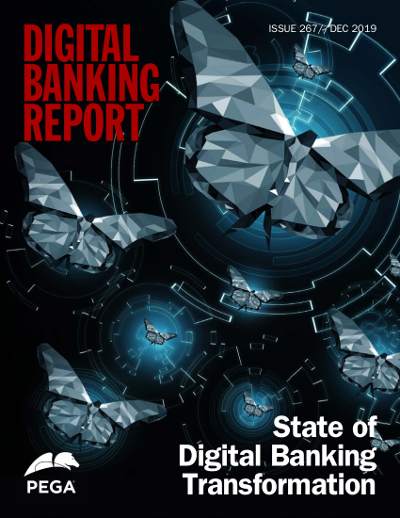State of Digital Banking Transformation
Jim Marous
December 2019
: DBR 267
74 pages, 37 tables/charts
Download Printable Version of this page
The integration of big data, advanced analytics, digital technologies, open banking APIs, the Internet of Things (IoT), Robotic Process Automation (RPA) and blockchain are disrupting every component of the banking ecosystem. This is dramatically impacting the way consumers bank and the way institutions deliver financial services.
In the past, the banking industry relied on mainframe-supported operations, focusing on delivering services using humans, ATMs and phone centers. Over the past decade, with the advent of the modern smartphone, digital technology has moved banking transactions out of the branch and on to mobile devices, with advanced data analytics allowing for more personalized delivery of services.
The pace of change in banking is accelerating exponentially today, with the most advanced organizations integrating vast collections of internal and external data, advanced analytics and extensive computing capability to deliver both financial and non-financial services in real-time, with contextual levels of personalization never before imagined.
Beyond immediate reporting of transactions and financial status, there is now the potential to provide proactive advice and solutions that can significantly improve a consumer’s daily life. More importantly, with digital delivery replacing expensive branch-based infrastructure, financial services can be significantly more inclusive, with much lower limits on size of transaction or relationship requirements.
The future of banking will feel more like the experiences delivered by non-financial firms such as Google and Amazon, with these organizations potentially becoming major players in the new ecosystem. Instead of locational convenience being the primary differentiator, financial services organizations will be competing on application design and speed, ease of use, seamless integration with other applications and the ability to deliver a personalized journey.
Digital banking transformation will require the elimination of product and data silos and a culture of innovation and willingness to change current business processes not evident at many traditional financial services organizations today. It is also clear that waiting to proceed is not a viable option, since the pace of change is faster than ever before and will never be this slow again.
This Digital Banking Report illustrates that executives in the financial services industry are aware of what is needed to succeed in the future. The challenge is that digital transformation maturity across the industry is very low, with the majority of organizations not in a position to deliver on consumer expectations in the near future. More concerning is that the future of banking already exists in markets like China.
We would like to thank Pega, who sponsored this research on the state of digital banking transformation. Their partnership enabled us to do the most comprehensive analysis of the progress of digital transformation ever done for the banking industry.
This report provides a perspective of not only what it takes to become a digital transformation leader, but also the challenges that will be faced. More importantly, this report provides the foundation for financial executives to create a digital transformation battle plan for the next year and beyond.
State of Digital Banking Transformation
Advanced Analytics, AI, Analytics, Artificial Intelligence, Bank, Banking, Big Data, Credit Union, CRM, Customer Experience, Digital Banking, Digital Lending, Digital Marketing, Digital Transformation, Engagement, Fintech, Innovation, Marketing, Mobile Banking, Payments, Personalization, Technology, Trends, Voice Banking, Voice-First

